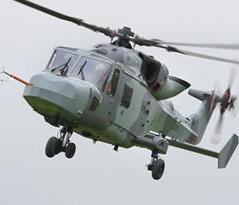|
|||||||||||
|
|
|
|||
|
By Daniel Baxter |
||||
 |
October 18, 2010 - AgustaWestland, announced that the second AW159 multi-role military helicopter successfully completed its maiden flight at AgustaWestland’s Yeovil facility yesterday. During its maiden flight a range of general handling checks were completed and it performed as expected. The aircraft, designated TI2, is the second of three test aircraft that will complete a 600 hour integrated flight test program. The third aircraft, TI3, is scheduled to join the flight test program in late October 2010. Aircraft TI1 continues to perform air vehicle and flight envelope testing while TI2 will undertake the flight testing of the aircraft’s core and mission avionics systems, the systems and software having already been developed and tested on AgustaWestland’s Full Systems Integration Rig (FSIR). |
|||
|
|
||||
|
TI3’s main task includes undertaking load survey trials and naval development, including ship helicopter operating limit trials. AgustaWestland has now also established a new AW159 production facility at its Yeovil plant that introduces a pulse line production system to bring significant efficiencies to the final assembly process. The first production airframe was delivered to AgustaWestland by GKN Aerospace on schedule in July 2010.
The first flight
of the second AW159, known as Lynx Wildcat in The British Army’s AW159 Lynx Wildcat will perform a wide range of tasks on the battlefield including reconnaissance, command and control, transportation of troops and materiel, and the provision of force protection. The Royal Navy variant will provide an agile maritime capability providing anti-surface warfare capability and force protection and will operate in support of amphibious operations and be an important element in defending ships against surface threats. There will be a high degree of commonality between the Army and Royal Navy helicopters that will mean that an aircraft can switch roles easily, principally through the changing of role equipment. The AW159 is powered by two new generation CTS800 engines, each capable of continuously producing 1281 shp giving the aircraft exceptional hot and high performance. The aircraft has an all up mass of 5790 kg with a built in capability to increase that to 6250 kg. The cockpit includes a fully integrated display system utilizing four 10x8 inch primary displays. Sensors include a nose mounted IR/TV imager with built in laser designator and for the maritime variant the Selex Galileo 7400E 360 degree active array radar. |
||||


